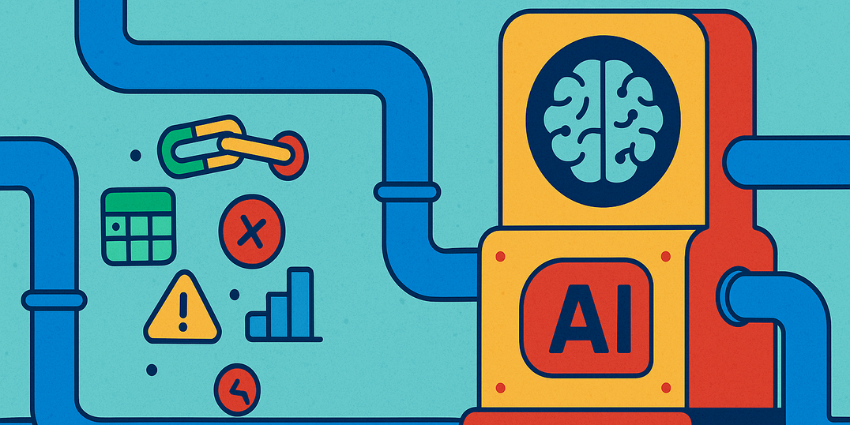ServiceNow has come a long way from its early days specializing in IT service management (ITSM) and helpdesk workflows.
Today, the cloud-based platform-as-a-service provider helps global organizations design, deploy, and automate enterprise-wide processes.
Beyond that, it specializes in specific subsets of enterprise tech.
For instance, it’s building significant momentum in the CRM market, acquiring Moveworks, Logik.ai, and CueIn in 2025 to further its charge.
Yet, enterprise AI appears ServiceNow’s biggest focus right now.
Indeed, the company aspires to become the “ultimate AI platform for business”.
By doing so, it’s delivering the latest, advanced AI, typified by its close NVIDIA partnership.
ServiceNow is also pulling together enterprise-wide workflows as an infrastructure for AI to thrive.
Then, there’s a small matter of its Data Fabric, centralizing business data and powering those AI deployments.
Of course, some enterprises buy into ServiceNow’s complete portfolio. Others leverage elements for ITSM, CRM, HR, etc.
Whatever the case, below is a deep dive into ServiceNow’s offerings and its mission in the enterprise tech space.
What Is ServiceNow?
ServiceNow is a cloud-based enterprise technology platform provider. Its platform has three core tenets: an applications suite, a central database, and a developer environment.
The applications typically fit into four broad categories: IT, employee, customer, and creator workflows.
Each app is highly customizable, and – as each category name suggests – brands can build workflows between them.
That does mean that ServiceNow implementations can be quite complex. However, ultimately, that complexity enables more distinct, data-rich business processes.
Also, with its industry solutions and workflows, ServiceNow is doing more and more of the busy work.
According to ServiceNow, all of these solutions are built on best practices and real-world experience.
Moreover, its platform is constantly growing, with the agentic AI boom inspiring another offering: ServiceNow Yokohama.
ServiceNow: The Four Core Workflows
Technically, ServiceNow does offer tools that go beyond its four “primary” workflow offerings, including finance and supply chain apps.
However, the company’s four main focus areas are IT, employee management, customer experience, and creator support.
All of those four workflow solutions are bundled together on the same infrastructure: the “Now Platform”.
The shared infrastructure allows companies to apply AI and machine learning across every workflow, empowers data to flow across applications and departments, and empowers companies to mix and match the essential tools they need.
1. IT Workflows
ServiceNow’s heritage is in IT Service Management (ITSM). Despite its expansion into a business drawing in $10MN+ in annual recurring revenue (ARR), IT management remains a big part of the portfolio.
Its IT Workflow” solutions empower companies to unite IT staff, risk management, and security operations in a single environment, with applications for:
- ITSM: The comprehensive ITSM suite includes a Configuration Management Database (CDM), knowledge management, “Now Assist” generative AI support, change management, incident management, predictive intelligence, and more.
- ITOM: A full IT Operations Management kit with certificate management, service mapping, discovery, firewalls, reporting tools, and metric intelligence.
- SPM: A Strategic Portfolio Management solution that combines scenario and strategic planning with investment funding insights, agile development, scaled agile frameworks, collaborative tools, and data capture solutions.
- ITAM: An IT asset management system for tracking the lifecycle of hardware, software, and cloud resources, across workflows, with onboarding and offboarding tools, cost management, and contract tracking.
- DevOps: A suite of developer tools for change velocity, config data management, value stream management, metrics, insights, and more.
- SecOps: These end-to-end AI-powered solutions for simplifying and automating threat and vulnerability management. This includes dashboards, vulnerability and security incident response, and threat intelligence tools.
The IT Workflows application kit also offers solutions for tracking and managing governance, risk, and compliance.
Plus, the kit comes with dedicated tools for operational technology management and telecommunications service operations management.
2. Employee Workflows
ServiceNow gives companies tools designed to enhance employee management, morale, and efficiency.
Moreover, its employee-focused solutions help organizations create safer, more productive working environments.
Core applications include:
- HR Service Delivery (HRSD): This automates HR tasks like onboarding and case resolution. It also comes with employee journey management tools and a single unified “employee center”.
- Workplace Service Delivery: This module handles reservations for conference rooms, floor plan info, or facility services. It also comes with a workplace concierge, case management tools, and analytics.
- Safe Workspace Suite: Designed for companies driving employees back into the office, the Safe Workplace Suite makes it easy to track potential threats, employee health details, and readiness surveys.
- Legal Service Delivery: This solution centralizes requests and procedures related to legal matters, with flexible tools for knowledge and contract management and a built-in mobile application.
ServiceNow’s employee workflow apps aim to house all staff requests, insights, and critical information under one umbrella, minimizing data silos and risks.
Additionally, across each app, ServiceNow aspires to offer leaders in-depth insights into their teams with end-to-end analytics.
3. Customer Workflows
Since officially entering the CRM market, ServiceNow’s presence in the customer experience space is likely to grow in the years ahead.
Already, it’s experimenting with unique solutions, like GenAI-powered avatars for service teams and customizable AI agents (more on that later).
Currently, the customer workflow applications focus on helping businesses create “seamless” customer experiences and bridge the gaps between customer-facing teams.
Key customer workflow applications include:
- Customer Service Management: A platform for customer service teams that includes omnichannel support, case management, knowledge management, self-service, proactive outreach, conversational intelligence, and a “360-degree customer view”.
- Sales & Order Management: A solution that connects front and back-office teams, so they can co-ordinate across sales and order lifecycles. From there, they may manage post-sale changes to grow revenue.
- Field Service Management: This “all-in-one” solution for field service teams combines schedule optimization with mobile agents, territory planning, dispatcher insights, capacity and reservation management, and more.
- Specialist Operations Apps: For specific industries, ServiceNow offers dedicated tools for financial services (such as dispute management apps), telecommunications (like apps for account lifecycle events and order management), and healthcare (such as the patient 360 app for comprehensive patient insights).
All these apps combine on the “Now” platform to help businesses create a more comprehensive view of the customer journey, collaborate with teams, and apply automation at scale.
4. Creator Workflows
The “Creator Workflows” component of the Now platform is a little smaller than the others but still a significant part of the ServiceNow platform.
Ultimately, it’s designed to give companies the tools they need to create intuitive experiences.
Users can build apps quickly with pre-built templates and low-code tools, design unified app experiences across workflows, and track data.
The main components here include:
- App Engine: A low-code environment for assembling internal apps or custom logic. This comes with the dedicated “Now Assist” tool for creators, Studio IDE, an intelligent flow designer, and a process automation designer.
- Integration Hub: A comprehensive selection of connectors for common business systems from vendors like SAP, Microsoft, and Oracle. Users can access flow templates, connections dashboards, REST API triggers, and spoke generators.
- Automation Engine: The Automation Engine consolidates tooling on the Now Platform with document intelligence, process mining, API management, and more. Users can even produce and consume Kafka events in ServiceNow workflows.
Additionally, ServiceNow offers specific types of tools for particular workforces.
For instance, its “Manufacturing Connected Workforce” toolkit is specifically designed to streamline innovation and improve safety for manufacturing teams.
Data and Agentic AI: The ServiceNow Edge
Part of what makes ServiceNow such a disruptive force in the SaaS market is its focus on adapting quickly, as evident in its recent strides in AI and data management.
Notably, it’s quickly building out the Service Data Fabric and AI Agent solutions. Here’s a closer look.
ServiceNow Data Fabric
ServiceNow, like many tech leaders, believes that agentic AI is the future of work. But, it also knows that to unlock the benefits of agentic systems, companies need a way to unify and connect critical data.
The ServiceNow Workflow Data Fabric solution is its answer.
Data Fabric empowers companies to connect, understand, and act on all forms of data from across hundreds of sources to support human and AI workflows.
Key features of the Data Fabric solution include:
- An Integration Hub: With 200+ out-of-the-box (OOTB) spokes and custom options.
- Conversational Spoke, Bot, and Playbook Generation
- Stream Connect: Process large-scale event streams within Apache Kafka.
- External Content Connectors: For sources like Sharepoint and Confluence.
- Process Mining: Continuously improve processes with real-time insights.
- RPA Hub: Integrate ServiceNow workflows with any system without APIs.
- Document Intelligence: A unified hub for crucial files and data.
- Automation Center: The dashboard where you can track your automation landscape.
- Boomi API Management: Full tracking for all connected APIs
For ServiceNow, what makes this solution so compelling is that it empowers companies to continuously improve and enhance their processes.
Indeed, they can connect their data sources with speedy integrations and use insights to unlock new opportunities.
ServiceNow even says that this system can reduce costs and ensure businesses can automate systems up to six times faster than usual.
ServiceNow AI Agents
AI isn’t just available from ServiceNow in the form of embedded AI and virtual assistants. The company is investing in a new generation of AI support: agentic AI.
AI agents are able to reason, adapt, and automate specific tasks. Moreover, they can collaborate to mechanize multi-step business processes.
ServiceNow has announced thousands of these AI agents, a studio for businesses to build their own, and an “AI Agent Orchestrator”.
The latter allows businesses to create a team of specialized agents that work together across systems and departments to achieve specific goals.
With agentic AI, ServiceNow focuses on bridging the gaps between apps, data, and workflows.
It claims that current AI agents are still built on fragmented legacy systems, but ServiceNow’s agents are unified, easy to orchestrate, and action-oriented.
These agents have full access to all of the data in the ServiceNow platform and can handle numerous multi-step requests with ease (like dealing with software provisioning for IT teams).
Moreover, they can operate across multiple channels, from email to chat, and provide access to autonomous and supervised modes for enhanced governance.
Finally, ServiceNow’s partnership with NVIDIA is particularly compelling. It equips ServiceNow with the latest hardware and developer tools to push the boundaries of AI.
Perhaps this is most evident in how the companies recently announced new tools to evaluate the accuracy and transparency of AI systems across departments.
What’s Next for ServiceNow?
ServiceNow has recognized the disruption in the technology industry and leaned into the opportunity.
It’s no longer content being a back-end solution for IT teams; ServiceNow wants to be the central platform that connects, improves, and augments every enterprise segment.
A big part of this vision is becoming the “ultimate AI platform”.
Indeed, ServiceNow hopes to use AI to – ultimately – triple its revenue to $30BN.
ServiceNow isn’t competing on price; instead, it’s focusing on platform integration and user experience, with a unified enterprise platform and a single environment for building, deploying, and managing AI systems.
Going forward, ServiceNow is exploring a three-pronged approach to AI innovation.
First, it’s focusing on organic innovation, with solutions like the Yokohama platform that will release thousands of AI agents into the workplace.
Next, it’s investing in targeted acquisitions, rolling up four companies in the first four months of 2025 alone.
Lastly, ServiceNow is exploring a range of strategic partnerships – such as the NVIDIA collaboration mentioned above – intended to improve access to secure AI and increase mindshare amongst front-office leaders.
This company isn’t just building generic tools. It’s giving organizations the intuitive solutions they need to reimagine, optimize, and automate the enterprise.







